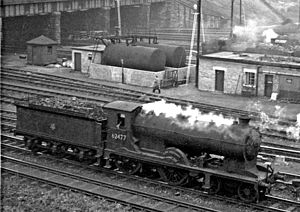NBR K Class
| NBR K Class LNER Class D26 / D32 / D33 / D34 | |||||||||||||||||||||||||||
|---|---|---|---|---|---|---|---|---|---|---|---|---|---|---|---|---|---|---|---|---|---|---|---|---|---|---|---|
 62477 Glen Dochart on Eastfield Locomotive Depot, Glasgow, September 1957 | |||||||||||||||||||||||||||
| |||||||||||||||||||||||||||
| |||||||||||||||||||||||||||
| |||||||||||||||||||||||||||
| |||||||||||||||||||||||||||
The NBR K Class is a class of 4-4-0 steam locomotive of the North British Railway. The first batch (later LNER Class D26) was designed by Matthew Holmes in 1902 and had 6-foot-6-inch (1.981 m) driving wheels for express passenger work. Three more batches (later LNER Classes D32, D33, and D34) were designed by William P. Reid with 6-foot-0-inch (1.829 m) driving wheels for mixed traffic work. This included perishable goods, such as fish from Mallaig and Aberdeen. They had inside cylinders and Stephenson valve gear. The D34 locomotives, commonly known as Glen Class, were built with superheaters. The LNER later fitted superheaters to all D26, D32, and D33 engines as well. All engines of the K class are sometimes known as Glen Class, although the designation is strictly reserved to the fourth (D34) batch.
LNER classes
[edit]The LNER divided the NBR K class into four classes, as below. It was common practice for the North British Railway to assign similar engines to the same class group, whereas the LNER system allowed only identical engines to bear the same class designation.
LNER Class D26
[edit]Twelve engines ordered in March 1902 and built at Cowlairs railway works in 1903. Three were withdrawn in 1922, leaving nine to enter LNER ownership in 1923. These nine had all been withdrawn by July 1926.[1]
LNER Class D32
[edit]Twelve engines ordered in 1905 and built at Cowlairs in 1906–07. The LNER began to fit superheated boilers in 1923 and classified the superheated locomotives D32/2. The non-superheated locomotives were classified D32/1.[2]
LNER Class D33
[edit]Twelve engines built at Cowlairs in 1909–10. The LNER fitted superheaters to all the D33s between 1925 and 1936.[3]
LNER Class D34
[edit]Ten engines built at Cowlairs in 1913. Twenty-two engines built between 1917 and 1920. All the D34s were built with superheaters. They are known as the Glen Class, as all engines in the group were named after Scottish glens.[4]
Post-NBR
[edit]The locomotives passed to the London and North Eastern Railway (LNER) in 1923 and, some of them, to British Railways (BR) in 1948. BR numbers [5] were:
- D32, five locomotives, 62445-62454 (with gaps)
- D33, nine locomotives, 62455-62466 (with gaps)
- D34, thirty locomotives, 62467-62498 (with gaps)
Accidents and incidents
[edit]- On 28 December 1906, locomotive No. 324 was hauling an express passenger train that was in a rear-end collision with a passenger train at Elliot Junction, Forfarshire. Twenty-two people were killed and eight were injured.[6]
Names
[edit]The D34s were named after Scottish Glens:

- 62467 Glenfinnan
- 62468 Glen Orchy
- 62469 Glen Douglas
- 62470 Glen Roy
- 62471 Glen Falloch
- 62472 Glen Nevis
- 62473 Glen Spean
- 62474 Glen Croe
- 62475 Glen Beasdale
- 62476 Glen Sloy
- 62477 Glen Dochart
- 62478 Glen Quoich
- 62479 Glen Sheil
- 62480 Glen Fruin
- 62481 Glen Ogle
- 62482 Glen Mamie
- 62483 Glen Garry
- 62484 Glen Lyon
- 62485 Glen Murran
- (62486 Glen Gyle)
- 62487 Glen Arklet
- 62488 Glen Aladale
- 62489 Glen Dessary
- 62490 Glen Fintaig
- (62491 Glen Cona)
- 62492 Glen Garvin
- 62493 Glen Gloy
- 62494 Glen Gour
- 62495 Glen Luss
- 62496 Glen Loy
- 62497 Glen Mallie
- 62498 Glen Moidart
No. 62494 was originally named Glen Gau, but since no glen of that name exists, it was renamed in July 1925, becoming Glen Gour.[7] Locomotives shown in brackets were withdrawn before Nationalisation.
Railway Roundabout
[edit]
In May 1959, the two cameramen of Railway Roundabout, Patrick Whitehouse and John Adams, visited the West Highland Line in Mallaig, and arranged a filming special taking place on a double-headed train from Glasgow Queen Street to Fort William. The two engines used, nos. 62496 Glen Loy and 62471 Glen Falloch were cleaned up and were in immaculate condition for the cameras. Photographs of the trip in color show Glen Loy and Glen Falloch with red smokebox numberplates and red siderods. The filming special had taken place over several days and used three runs of the trip in the process. The first trip saw a Southern Railway luggage van behind the engine hauling the train, Glen Falloch, and many lineside shots were possible. Filming on the third train showed a view from the back of the train approaching Rannoch. When the film was ready for broadcasting, it was entitled Two Glens to Fort William and was broadcast on 8 December 1959.
This film, along with 100 others, was purchased from Patrick Whitehouse and John Adams by the National Railway Museum and can still be seen today in the National Railway Museum at York.[8]
Preservation
[edit]
Withdrawals began in 1946 and all the D34s had been withdrawn by 1961. One, 256 Glen Douglas (BR number 62469) has been preserved by the Scottish Railway Preservation Society. It is now on display at the Riverside Museum in Glasgow.
References
[edit]- ^ "LNER Encyclopedia: The LNER Holmes D26 (NBR Class K) 4-4-0 Locomotives".
- ^ "LNER Encyclopedia: The LNER Reid D32 (NBR Class K) 4-4-0 Locomotives".
- ^ "LNER Encyclopedia: The LNER Reid D33 (NBR Class K) 4-4-0 Locomotives".
- ^ "LNER Encyclopedia: The LNER Reid D34 'Glen' (NBR Class K) 4-4-0 Locomotives".
- ^ Ian Allan ABC of British Railways Locomotives, 1948 edition, part 4, page 20
- ^ Gerard, Malcolm; Hamilton, J. A. B. (1984) [1967]. Rails to Disaster. London: George Allen & Unwin. pp. 13–19. ISBN 0-04-385103-7.
- ^ Boddy, M.G.; Brown, W.A.; Fry, E.V.; Hennigan, W.; Manners, F.; Neve, E.; Tee, D.F.; Yeadon, W.B. (April 1968). Fry, E.V. (ed.). Locomotives of the L.N.E.R., part 4: Tender Engines - Classes D25 to E7. Kenilworth: RCTS. pp. 45, 48. ISBN 0-901115-01-0.
- ^ "Two Glens to Fort William - High Life Highland".
